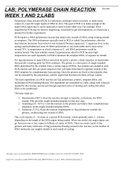Bios 390 week 1 2 lab 1 Study guides, Class notes & Summaries
Looking for the best study guides, study notes and summaries about Bios 390 week 1 2 lab 1? On this page you'll find 11 study documents about Bios 390 week 1 2 lab 1.
All 11 results
Sort by
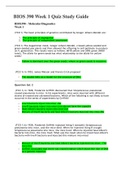
-
BIOS 390 Week 1 Quiz Study Guide (LATEST UPDATE) | Download To Score An A
- Exam (elaborations) • 11 pages • 2022
-
- $10.99
- + learn more
BIOS 390 Week 1 Quiz Study Guide BIOS390 – Molecular Diagnostics Week 1 (TCO 1) The basic principles of genetics contributed by Gregor Johann Mendel are: 1. The principle of segregation 2. T he principle of independent assortment (TCO 1) The Augustinian monk, Gregor Johann Mendel, crossed yellow-seeded and green-seeded pea plants and then allowed the offspring to self-pollinate to produce an F2 generation. The results were as follows: 6018 yellow and 2002 green (8020 total). The allele for gre...
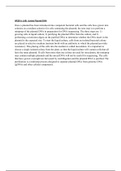
-
BIOS 390 Molecular Biology With Lab-Devry Latest Update 2023/2024
- Package deal • 8 items • 2020
-
- $15.49
- + learn more
BIOS 390 Week 1 LAB 1: Polymerase Chain Reaction BIOS 390 Week 1 Quiz Study Guid BIOS 390 Week 2 LAB 2: Gel Electrophoresis BIOS 390 Week 2 Quiz Study Guide BIOS 390 Week 3 LAB: DNA Cloning BIOS 390 Week 4 LAB: Gene expression BIOS 390 Week 5 LAB: Transcription in Prokaryotes-Verified BIOS 390 Week 6 LAB: Isolate Plasmid DNA-Verified
BIOS 390 Week 1, 2 LAB 1

-
BIOS 390 WEEK 6: LAB: isolate Plasmid DNA
- Exam (elaborations) • 1 pages • 2022
-
- Free
- + learn more
BIOS 390 WEEK 6: LAB: isolate Plasmid DNABIOS 390 BIOS . BIOS 390 WEEK 6: LAB: isolate Plasmid DNA Once a plasmid has been introduced into competent bacterial cells and the cells have grown into colonies on a medium selective for cells containing the plasmid, the next step is to perform a miniprep of the plasmid DNA in preparation for DNA sequencing. The three steps are: 1) growing cells in liquid culture; 2) purifying the plasmid DNA from the culture; and 3) performing a restriction diges...

-
BIOS 390 Week 6 LAB: Isolate Plasmid DNA-Verified
- Case • 1 pages • 2020
- Available in package deal
-
- $8.49
- + learn more
BIOS 390 Week 6 LAB: Isolate Plasmid DNA-Once a plasmid has … introduced into competent bacterial cells and the cells have grown into colonies on a medium selective for cells containing the plasmid, the next step is to perform a miniprep of the plasmid DNA in preparation for DNA sequencing. The three steps are: 1) growing cells in liquid culture; 2) purifying the plasmid DNA from the culture; and 3) performing a restriction digest on the purified DNA to determine whether the DNA insert in the ...
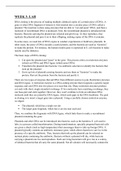
-
BIOS 390 ERIC KYLE WEEK 3 & 4 : LAB
- Exam (elaborations) • 4 pages • 2021
-
- $10.49
- + learn more
BIOS 390 ERIC KYLE WEEK 3 & 4 : LAB DNA cloning is the process of making multiple, identical copies of a certain piece of DNA. A gene or other DNA fragment of interest is first inserted into a circular piece of DNA called a plasmid. The insertion is done using enzymes that are able to “cut and paste” DNA, and then a molecule of recombinant DNA is produced. Next, the recombinant plasmid is introduced into bacteria. Bacteria carrying the plasmid are selected and grown up. As they reproduce, ...
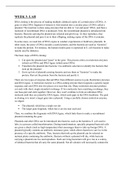
-
BIOS 390 ERIC KYLE WEEK 3 & 4 : LAB
- Exam (elaborations) • 4 pages • 2021
-
- $10.49
- + learn more
BIOS 390 ERIC KYLE WEEK 3 & 4 : LAB DNA cloning is the process of making multiple, identical copies of a certain piece of DNA. A gene or other DNA fragment of interest is first inserted into a circular piece of DNA called a plasmid. The insertion is done using enzymes that are able to “cut and paste” DNA, and then a molecule of recombinant DNA is produced. Next, the recombinant plasmid is introduced into bacteria. Bacteria carrying the plasmid are selected and grown up. As they reproduce, ...
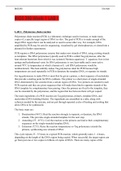
-
BIOS 390 Week 1 LAB 1
- Case • 4 pages • 2021
-
- $10.00
- + learn more
BIOS 390 Week 1 LAB 1 LAB 1: Polymerase chain reaction Polymerase chain reaction (PCR) is a laboratory technique used to increase, or make many copies of, a specific target region of DNA in vitro. The goal of PCR is to make enough of the target DNA region that it can be analyzed or used in some other way. For example, DNA amplified by PCR may be sent for sequencing, visualized by gel electrophoresis, or cloned into a plasmid for further experiments. PCR requires a DNA polymerase enzyme tha...
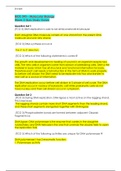
-
BIOS 390 Quiz Study Guide | Molecular Biology With Lab_14 SETS | Guaranteed Pass A+
- Exam (elaborations) • 8 pages • 2021
-
- $10.99
- + learn more
Question Set 1 (TCO 1) The basic principles of genetics contributed by Gregor Johann Mendel are: (TCO 1) The Augustinian monk, Gregor Johann Mendel, crossed yellow-seeded and green-seeded pea plan ts and then allowed the offspring to self-pollinate to produce an F2 The results were as follows: 6018 yellow and 2002 green (8020 total). The allele for green seeds has what relationship to the allele for yellow seeds? (TCO 1) In 1953, James Watson and Francis Crick proposed. Question Set 2 (TCO 1) In...
BIOS 390 Week 1 LAB 1: Polymerase Chain Reaction, BIOS 390 Week 2 LAB 2: Gel Electrophoresis

